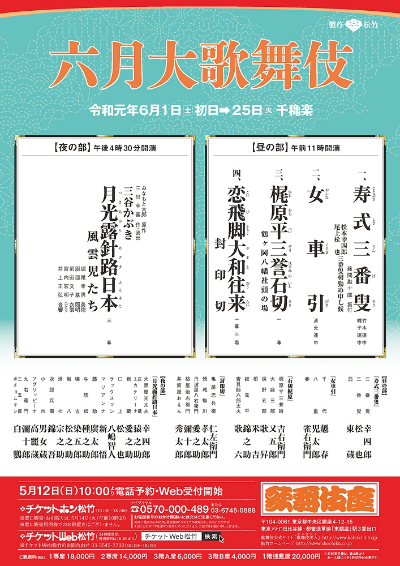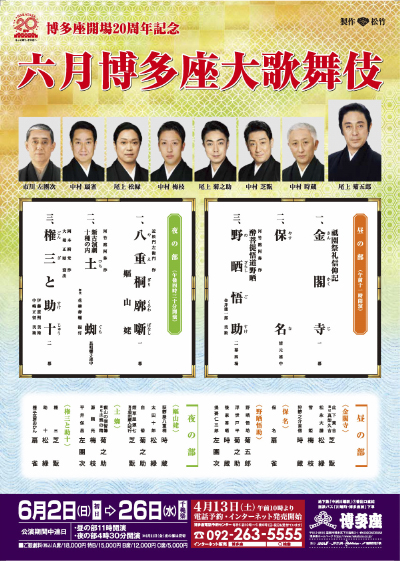| JUNE 2019 |
|
3 shows in T˘ky˘ (Kabukiza, National Theatre), 1 in Ky˘to (Minamiza), 2 in Fukuoka (Hakataza) and 1 in Shimonoseki (Shimonoseki Shimin Kaikan)!
|
| Kabukiza (T˘ky˘) |  |
| Dates | 1 ~ 25 June 2019 Rokugatsu ďkabuki June Grand Kabuki |
| MatinÚe |
Onna Kurumabiki |
| Evening |
Tsukiakari Mezasu Furusato (Fűunjitachi) |
| Casting |
Living National Treasure Nakamura Kichiemon, Living National Treasure Kataoka Nizaemon, Living National Treasure Nakamura T˘z˘, Matsumoto Haku˘, Ichikawa Ennosuke, Matsumoto K˘shir˘, Nakamura Jakuemon, Nakamura Kaishun, Kataoka Ainosuke, Nakamura Kinnosuke, Kataoka Takatar˘, Kataoka Hidetar˘, Band˘ Yajűr˘, Band˘ Takesabur˘, Nakamura Karoku, Nakamura Matagor˘, Ichikawa Komaz˘, Onoe Matsuya, Nakamura Kotar˘, Ichikawa Omez˘, Nakamura Matsue, Matsumoto Kingo, Sawamura Yoshijir˘, ďtani Keiz˘, Nakamura Kichinoj˘, Ichikawa Juen, Sawamura S˘nosuke, Ichikawa Somegor˘, Nakamura Kash˘, Nakamura Yonekichi, Nakamura Tanenosuke, Band˘ Shingo, Nakamura Takanosuke, ďtani Hirotar˘, Ichikawa K˘tar˘, Nakamura Tsurumatsu, Kataoka Matsunosuke, Yashima Norito |
| Comments |
The traditional programs for the June Grand Kabuki at the Kabukiza.
|
 |
|
|||
| Dates | 2 ~ 26 June 2019 Rokugatsu Hakataza ďkabuki June Hakataza Grand Kabuki |
||
| MatinÚe |
Gion Sairei Shink˘ki (Kinkakuji) Nozarashi Gosuke |
||
| Evening | |||
| Casting |
Living National Treasure Onoe Kikugor˘, Nakamura Tokiz˘, Nakamura Shikan, Onoe Kikunosuke, Nakamura Senjaku, Ichikawa Sadanji, Nakamura Baishi, Onoe Sh˘roku, Ichimura Manjir˘, Band˘ Hikosabur˘, Band˘ Kamez˘, Kawarasaki Gonjűr˘, Band˘ Shűch˘, Onoe Ukon, Nakamura Mantar˘, Nakamura Hashinosuke, Nakamura Fukunosuke, Ichimura Kitsutar˘ |
||
| Comments |
The traditional two programs for the June Grand Kabuki at the Hakataza.
|
||
 |
| National Theatre (T˘ky˘) |
| Dates | 2 ~ 24 June 2019 Rokugatsu Kabuki Kansh˘ Ky˘shitsu June Kabuki Appreciation Class |
| Program |
Kabuki no Mikata |
| Casting | |
| Comments |
Educational program at the National Theatre called Kabuki Kansh˘ Ky˘shitu ('Kabuki Appreciation Class'). This is a very interesting formula for the beginners because there is lively presentation on stage (Kabuki no Mikata) of Kabuki or some aspects of the art like music, stage tricks or fighting scenes. It is followed by the drama "Tonbŕ Sumika".
|
|
|||
| Dates | 2 ~ 26 June 2019 | ||
| Program |
NARUTO |
||
| Casting |
Band˘ Minosuke, Nakamura Hayato, Nakamura Baigyoku, Ichikawa Emiya, Ichikawa Emisabur˘, Ichikawa En'ya, Nakamura Umemaru, Ichinose Hidekazu, Kashima Noritoshi |
||
| Comments |
Kishimoto Masashi's internationally popular manga "NARUTO" got its Kabuki adaptation in August 2018 at the Shinbashi Enbuj˘, under the supervision of G2 (both writer and director). This month it is staged in Ky˘to at the Minamiza. The roles of Uzumaki Naruto and Uchiha Sasuke are played by Band˘ Minosuke and Nakamura Hayato. The guest star Nakamura Baigyoku plays the role of Uchiha Madara.
|
||
 |
| Shimonoseki Shimin Kaikan (Shimonoseki) | |
| Dates | 28 June 2019 Band˘ Tamasabur˘ Tokubetsu Buy˘ K˘en Band˘ Tamasabur˘ Special Dance Performances |
| Program |
Yukari no Tsuki Kosunoto Kane-ga-Misaki |
| Casting |
Living National Treasure Band˘ Tamasabur˘ |
| Comments |
A special Buy˘ program starring the amazing Living National Treasure onnagata Band˘ Tamasabur˘ in Shimonoseki at the Shimonoseki Shimin Kaikan (Shimonoseki Civic Center). It celebrates the 130th anniversary of the city of Akamagaseki, the former name of Shimonoseki.
|
|
|
| Contact | Main | Top | Updates | Actors | Plays | Playwrights | Programs | Links | FAQ | Glossary | Chronology | Illustrations | Prints | Characters | Derivatives | Theaters | Coming soon | News |
